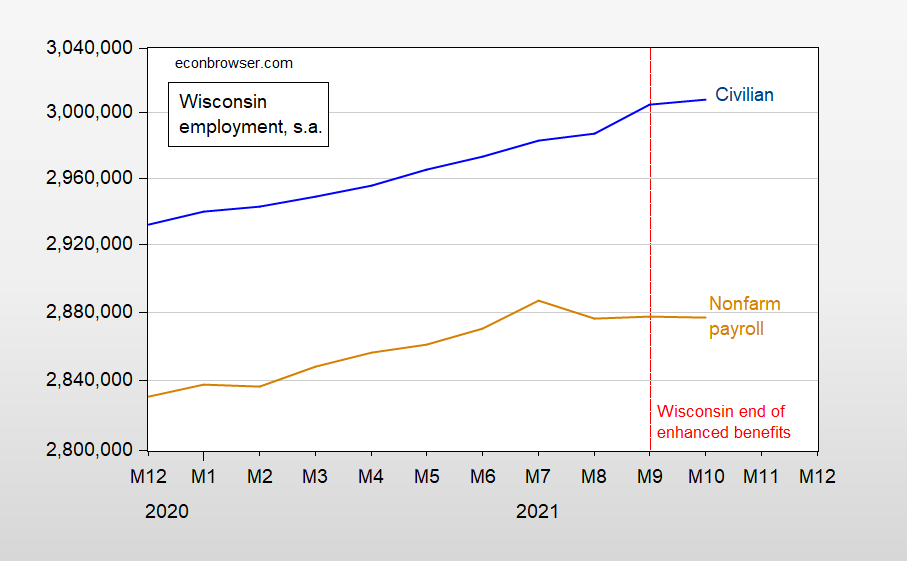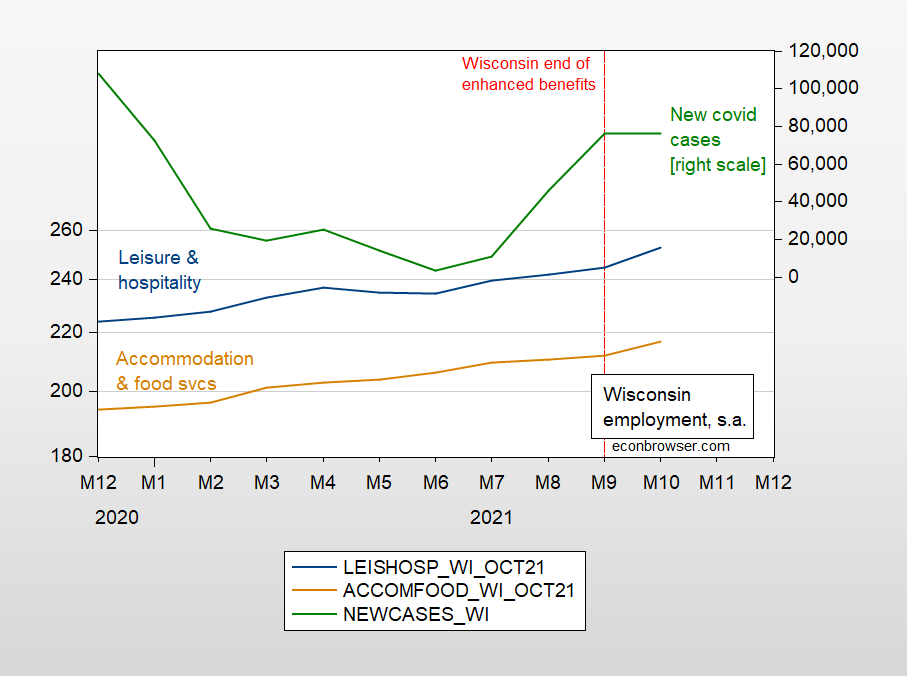As of September 4th, enhanced unemployment benefits were ended in Wisconsin. What do the latest data reveal?
Concisely:
- (Measured) labor force shrinks
- Employment shows mixed impacts
- Leisure and hospitality shows some acceleration
These points are highlighted in the following figures:
Figure 1: Wisconsin labor force, seasonally adjusted (blue), on log scale. Source: BLS.
Figure 2: Wisconsin civilian employment (over 16), seasonally adjusted (blue), and nonfarm payroll employment (from establishment survey), both on log scale. Source: BLS.
Even in the absence of errors in dealing with outliers (as noted in the BLS release), the household survey at the state level is subject to much greater variance than the establishment series. Hence, one should take with a grain of salt any short term movements in the labor force and civilian employment series (see more discussion here). The establishment survey shows no big movements in aggregate employment after the end of enhanced benefits on 4th September (a little before the survey dates in early-mid of each month).
Some have argued that what we should be paying attention to is high-contact services. Yesterday’s post showed the contrast between manufacturing and leisure and hospitality, but below is a detail on accommodation and food services as well as overall leisure and hospitality.
Figure 3: Wisconsin employment in leisure and hospitality services (blue, left), and in accommodation and food services (brown, left), both seasonally adjusted on log scale; and new covid-19 cases (green, right scale). Source: BLS, and Wisconsin Department of Health Services.
While there is some acceleration in these service industry employment growth rates, it’s unclear if it’s due to the improvement the covid situation that drives the development.
In general, I’m not aware of any robust evidence that employment surged in the wake of enhanced benefits program termination, state-by-state. PBS NewsHour has one recent article. For a more formal analysis which covers the experience pre-September, see this paper.



Off topic but timely. Citizens for Tax Justice has noticed how the radical right are celebrating that the punk Rittenhouse got away with murder and ties to other obnoxious positions of the radical right:
https://taxjustice.medium.com/where-the-rights-lionizing-of-kyle-rittenhouse-intersects-with-tax-sentiment-c9da369eb0cb
Wow……… I thought it was certain to end in a hung jury. Well, i guess i am the total fool on this one. FULL mea culpa.
“America the beautiful”, automatic guns and apple pie.
The MAGA hatters raised $2 million for the defense of their little punk. Talk about the Dream Team. n
It’s outrageous!!!
How can we live in a country where a violent child [five each tots ages five to 11] rapist can’t try to kill someone and not get shot?
KR is not a hero. He will have to live the rest of his life with this tragedy and the proceeds of $1,000,000,000 in righteous lawsuits.
They call it the “Nick Sandmann Dividend.”
“the proceeds of $1,000,000,000 in righteous lawsuits.”
I doubt the civil lawsuits impose $1 billion in fines on this pathetic little punk but even if they do, they are all sorts of disgusting Trump fan boys who would pony up funds for this little “hero”. Heck – a couple of the more repugnant GOP Congress people want this murdered on their staff.
Wow! Demented PGL blinded by his inaccurate, inappropriate, incomplete and totally biassed MSNBC reporting can not see the actual meaning in T. Shaw’s comment.
PGL, as a dedicated CNN/MSNBC watcher, clearly doesn’t even know about the “Nick Sandmann Dividend.” is. Why would he? They so misreport, he probably never saw ~$250 million he reportedly received on the other networks. Does PGL know that MSNBC was banned from the court house by the judge?
PGL continues to represent the prototypical liberal with his misreading of a simple phrase: “Nick Sandmann Dividend.”
CoRev,
There is a rather large difference between Nick Sandman and Kyle Rittenhouse. The former not only broke no laws he was misrepresented by the networks you mention in what he did and how he related to the Native American man he encountered. He did absolutely nothing wrong.
Rittenhouse may have been found “not guilty” of homicide, but that is not the same thing as being found “innocent.” And while the judge let him off on a technicality, he clearly broke the law, taking a gun he was not allowed to possess illegally across state lines to insert himself into an ongoing civil disorder where he killed a man who threw a plastic bag at him and did not even hit him and then subsequently killed another man and seriously wounded a third, with the jury finding him doing all of those things in self-defense. But none of this would have happened if he had not violated the law in the first place by illegally carrying that gun into that situation.
Nick Sandman did not kill anybody or do anything else remotely similar to what Rittenhouse did. As it is, the most likely civil lawsuit will be by the families of those people Rittenhouse unequivocally shot dead against him. Any suit by him will be a joke and completely overwhelmed by the ones likely to be brought against him. The networks accurately reported what Rittenhouse did, in contrast to how they reported what happened with Sandman. These cases are not remotely similar. Don’t kid yourself, CoRev. Even somebody with a Womens’ Studies degree from Mystery University as you claim to have should be able to figure this out.
i wonder if you would feel the same way if a black man walked through a white neighborhood, and when confronted by gun toting neighbors shot them in perceived self defense. would you stand behind the rights of that black man, corev? or would you throw him in jail?
Menzie,
Very wise of you to note how BLS reports greater variance of the household surveys. I am sure rsm will be grateful that you did nor murder anybody today.
Plenty of silence from those arguing that unemployment benefits were keeping people on the sidelines. Can we retire those arguments now? Or will some of you continue to argue in bad faith?
I guess the reporting will have to wait for rsm to report his confidence intervals.
There are just so many confounding factors on the increased employment in the service sectors that it will be difficult to make any firm conclusions. The wast majority of those not in the labor force were not eligible for enhanced unemployment benefits anyway – so they would not be drawn back because of reduced benefits. However, increased salaries may draw them back – resolution of child care issues and changes in the risk of (levels of) infections would also bring more people back to work (regardless of whether they did or did not get benefits).
The best way to find out why employment increased would probably with a survey of reasons for accepting a new service sector job. What % came from other jobs (service sector or not), from unemployment without getting benefits or with getting benefits. Did those percentages change after the enhanced benefits were removed? What were the reasons for accepting the new job (removal of barriers or increased incentives).